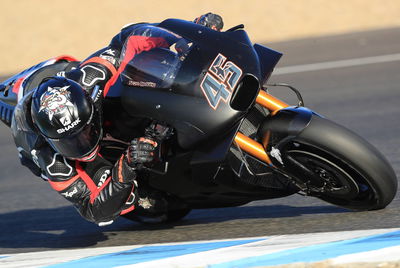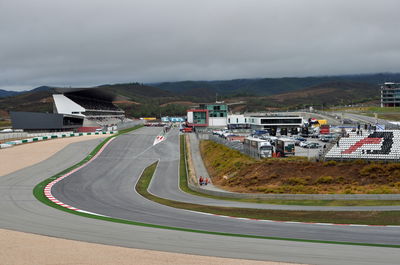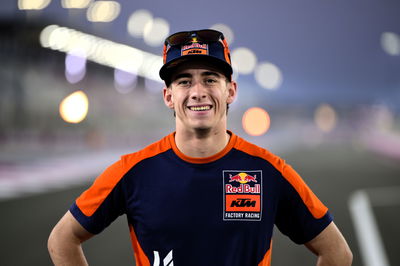Redding: Aprilia set-up much improved in Jerez
A week is a long time in racing. To this, Scott Redding can attest, as the Englishman used three days in the Andalusian sun to continue his adaption to Aprilia’s MotoGP RS-GP machine and found it much more to his liking than his previous outing seven days before.
Thanks to a number of set-up changes, Redding said the RS-GP now felt like a “normal bike”, with its strength in braking and corner entry becoming clear. The chassis, which he felt to be much too stiff at Valencia, was much improved too, thanks to continued tinkering from his new crew.

A week is a long time in racing. To this, Scott Redding can attest, as the Englishman used three days in the Andalusian sun to continue his adaption to Aprilia’s MotoGP RS-GP machine and found it much more to his liking than his previous outing seven days before.
Thanks to a number of set-up changes, Redding said the RS-GP now felt like a “normal bike”, with its strength in braking and corner entry becoming clear. The chassis, which he felt to be much too stiff at Valencia, was much improved too, thanks to continued tinkering from his new crew.
And there is still much to come. At the close of the second of a three-day test, Redding said he had yet to begin work on the bike’s electronics. Until then chassis and working on his own riding style had taken precedent.
“It was good,” said Redding on Thursday evening, having ended the day with the 13th fastest time, 1.6 seconds in arrears of Andrea Dovizioso’s new circuit record.
“We tested a lot. Coming from Valencia, we went with that base. We changed the bike to how I want it. It’s working quite well. Yesterday we made some changes to how it was working and it feels like a ‘normal bike’, let’s say.
“I struggled a bit in Valencia to understand the bike. But with these changes we made it helped me get that back, what I’m used to. Honestly the bike feels good. We did a lot of stuff today, a lot of stuff. We came back to my base and I felt like how I can ride I can use the bike.
“Honestly, it feels a bit like a Moto2 in the braking and entry. We just need to work a bit on traction and rear edge grip. The steps we made have been big. We made some good, some bad. I need to find all this stuff out myself, and that’s mainly chassis.
“We still need to work a lot on electronics and other stuff. I’ve found the balance, and said, ‘Lets test this, this and this.’ They need to know for the new bike for next year. It was basically a shakedown throughout the day. And we came back to what we think is a good base. And it was a good base in the end.”
Redding’s comments on the RS-GP’s shortcomings were similar to those echoed by ’17 rider Aleix Espargaro throughout the year. The rear traction when the bike is leant over is not quite what it should be. Only when the 24-year old has picked the bike up does he feel it driving forward.
“Slow corners at full angle I struggle – so turn two and six. But the faster stuff like turn four and seven, the grip is sort of leaving me before I take the gas. When I take it, it doesn’t go onto the track; it goes sideways and I lose the drive.
“It’s more at the lean,” he said. “When I get the bike picked up, I have traction. But with this bike we need to use higher RPM to make it go, but I need to wait to make it go. I need to bring that earlier.”
Another deficiency Redding noticed was the RS-GP’s inability to extract the maximum from a new tyre; a problem that hindered Sam Lowes in qualifying through ’17, and stretches back to the season before, this bike’s first year in MotoGP.
“This bike is really good with a used tyre,” said Redding. “You can make the lap-time with whatever set-up. The problem is when you put the new tyre. When I came back in at the end I could improve my time from yesterday.
“For me, this test is not about lap times. I said already at Valencia on day one I’m not worried about lap times. If I feel comfortable to do it, I’ll do it. I want to see if this works, or that doesn’t work.
“We’ll go away for the winter, bring the new bike with the things that work and then go from there. For me this is a shakedown. They need information from me for the new bike. If I’m saying, ‘I can’t get the lap time!’ then I’m going to be in the same shit next year. At least I can give them information to take back over the winter, so they can see that it’s like this for Aleix and like that for me.”
On having a week to process his first impressions from Valencia, where Redding used Espargaro’s set-up, and found “It didn’t suit me at all. I couldn’t get at home on it. I was nowhere near,” the Englishman commented, “It’s better.
“Obviously coming from Ducati at Valencia and changing the bike is hard. I immediately felt better here and even more comfortable on the bike. It’s still a little bit on the aggressive side and we do need to fix that. Already it’s become easier.
“And we haven’t really worked on electronics – just mainly the chassis and my riding style. We don’t want to change too much and get ourselves lost. The edge – a bit of chassis and electronics. At Valencia it was really snappy on the spin and that’s why I found it aggressive. The bike was stiff, it didn’t move and was just relying on the tyre.
“Now I’ve got more feeling with the bike and I can anticipate more how aggressive it is and make it much more manageable.”
Like the Valencia test, Redding was using the same spec of machine as Espargaro, bar the gearbox. With test rider Eugene Laverty filling in for the injured Espargaro at Jerez, Aprilia was keen to receive all feedback before returning to Noale to perfect the ’18 bike, which will be unveiled next January











